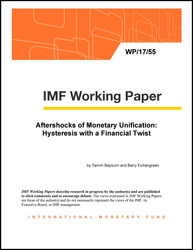
Aftershocks of Monetary Unification
Hysteresis with a Financial Twist
Once upon a time, in the 1990s, it was widely agreed that neither Europe nor the United States was an optimum currency area, although moderating this concern was the finding that it was possible to distinguish a regional core and periphery (Bayoumi and Eichengreen, 1993). Revisiting these issues, we find that the United States is remains closer to an optimum currency area than the Euro Area. More intriguingly, the Euro Area shows striking changes in correlations and responses which we interpret as reflecting hysteresis with a financial twist, in which the financial system causes aggregate supply and demand shocks to reinforce each other. An implication is that the Euro Area needs vigorous, coordinated regulation of its banking and financial systems by a single supervisor—that monetary union without banking union will not work.
Publication date: March 2017
ISBN: 9781475586220
$18.00
Add to Cart by clicking price of the language and format you'd like to purchase
Available Languages and Formats
| English |
Prices in red indicate formats that are not yet available but are forthcoming.
Topics covered in this book
This title contains information about the following subjects.
Click on a subject if you would like to see other titles with the same subjects.
Optimum currency area , European Monetary union , hysterisis
Summary
Copyright © 2010 - 2025
Powered by:
AIDC



